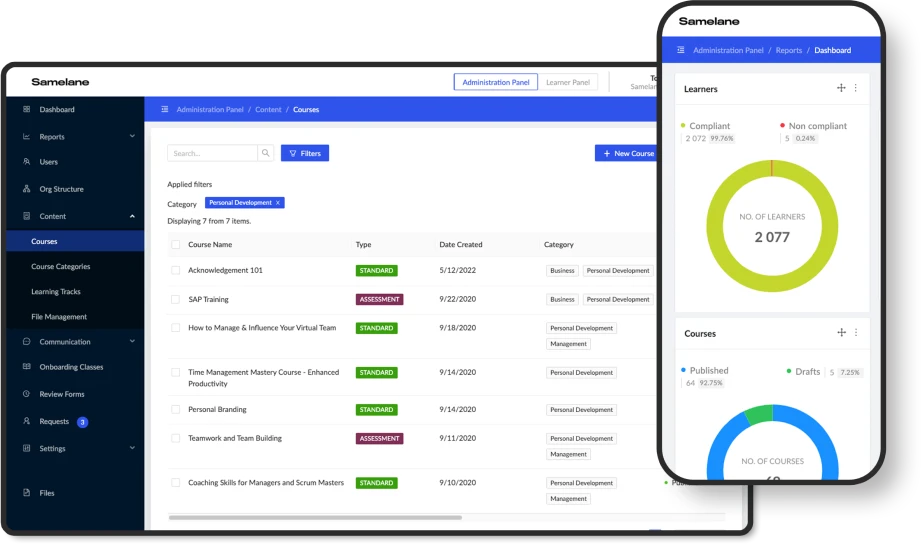Providing feedback is a core element in workplace communication. It can apply to employee performance, development, and behavior. Constructive feedback can boost a person’s self-assurance, eagerness to learn, and, ultimately, their achievements. Apparently, according to Gallup, 80% of employees who report receiving meaningful feedback within the previous week were highly engaged. But the key lies in proper delivery and providing feedback is art in itself.
Providing helpful input can take various forms and approaches. In this article, we provide customer feedback examples and explain how to use them to build successful teams and a thriving workplace culture.
What is feedback in communication?
When it comes to defining, feedback in workplace communication refers to the process of providing constructive information to an employee about their:
- performance
- hard and soft skills
- behavior
- skill development
- alignment with organizational culture

counter the Big Quit with high retention strategies
For feedback to be constructive, it should exhibit characteristics such as:
- Be specific and refer to particular actions or behavior
- Be actionable, so an employee knows what to improve and how
- Be timely, delivered soon after a particular behavior happens; it doesn’t apply to feedback provided regularly, like quarterly or yearly reviews
- Be supportive, focused on improvement rather than criticism
- Be two-way, allowing and encouraging employees to provide their perspective
Feedback can take three most common forms:
- Verbal feedback is given through spoken words and can be delivered in person, over the phone, through video conferencing, or informal chats. It allows for immediate discussion and clarification, and can be more personal and interactive.
- Written feedback is provided through written performance reviews, reports, comments, notes, online surveys, emails or even QR codes. QR codes can be used to link to detailed feedback forms or documents, making it easy for recipients to access comprehensive evaluations digitally.
- Nonverbal feedback is communicated through body language, facial expressions, tone of voice, and proximity. It can be ineffective if provided without verbal input because it can be interpreted differently than intended.
It’s important to note that destructive feedback also exists. It focuses on criticizing or belittling the recipient. It’s harmful and doesn’t contribute to improved performance or engagement. Therefore, we should avoid it in the workplace at all times.
The skill of providing feedback
Great managers and team leaders use feedback to create a development-focused culture. It can be a powerful tool that yields noticeable positive outcomes but can also cause harm, diminish self-esteem, or make individuals feel undervalued. Here are some tips on how to give and receive feedback effectively:
- First, refrain from statements that might be interpreted as accusatory or judgmental; your goal is to motivate and highlight areas for growth, not the opposite. Emphasize the benefits of open communication regarding potential improvements to your team. Begin by acknowledging your employee strengths, then discuss areas for further development.
- Ensure you are specific and provide evidence. Your team members should clearly understand what went wrong and how to improve. Provide feedback as soon as possible after the event or situation in question. Waiting too long can make the feedback less effective. Stick to the facts and focus on the behavior or performance, not the person.
- Allow employees to process your feedback and encourage them to share their thoughts. Remain receptive to their perspectives and don’t deny them.
- Be considerate and offer suggestions for improvement or solutions to problems instead of just pointing out flaws. Use a positive and respectful tone, and avoid being overly critical or negative. Remember that the goal is to help the other person grow and improve.
- Finally, invite employees to offer feedback as well. Set aside your ego, inquire about their thoughts on your performance and managerial role, and attentively listen to their input. Then, collaboratively discuss and identify ways to utilize their review effectively. Acknowledge and appreciate the employee who had the courage to provide feedback, even if it was difficult to hear.
What is the importance of feedback in communication?
Feedback is a critical element of effective workplace communication. It plays a crucial role in the communication process, acting as the bridge between the sender and the receiver. It prompts an employee’s response, thereby completing the two-way communication loop. Thus, it reflects the effectiveness of communication between both parties involved.
The top benefits of feedback
So, what makes feedback so valuable? Let’s examine how team leaders can utilize feedback to enhance communication and team performance.
- Feedback generates direct business advantages by improving overall performance. Identifying strengths and weaknesses allows employees to focus on improvement and become more effective in their roles.
- Regular feedback fosters personal and professional development. Thoughtful input helps employees track their progress toward goals, keeping them motivated and focused on achieving desired outcomes.
- Feedback increases engagement. Employees who receive regular feedback feel more valued and recognized for their contributions. It fosters a sense of ownership and engagement in their work.
- Feedback maintains alignment. It benefits everyone engaged in various activities, such as working on projects.
- Feedback strengthens relationships and teamwork. It encourages honesty and trust. Although it may involve constructive criticism, it builds rapport between team members and managers. As a result, feedback creates a more collaborative and supportive work environment.
- Feedback helps teams avoid significant errors. Fostering open and honest communication during teamwork minimizes the time spent on corrections and reduces miscommunication-induced errors.

Feedback in business
In the business world, feedback serves as valuable information or constructive critique concerning a company’s actions or behaviors or those of individuals within the company.
Effective feedback is considered a vital management tool across all industries. Based on the input received, companies can adjust their actions to align with client, employee, supplier, and stakeholder information. Moreover, customer feedback provides insights into clients’ needs, presenting new opportunities for company growth.
By attending to employee feedback, a company can gain deeper insights than what analytics alone can reveal. When employees feel heard and valued, it helps reduce confusion and ambiguity. Regular, constructive evaluations can significantly improve efficiency and work-related achievements. Feedback facilitates proper coordination between departments, ensuring top-level management stays informed about organizational activities.
Effective communication, marked by a continuous exchange of feedback, can help resolve company issues. Concluding, feedback is critical for the successful operation of any business.











